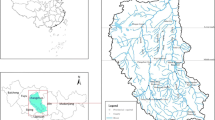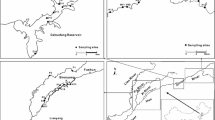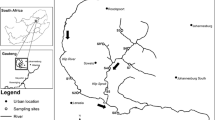Abstract
The distributions of organic pollutants (like hydrocarbons, polychlorinated biphenyls (PCBs), and pesticides) and the risks on the ecosystem were studied in the Durance River and the Berre lagoon (France). High levels of aliphatic hydrocarbons were observed in all stations (1399 to 11,202 μg kg−1 dw). The n-alkanes were mainly from terrigenous origin confirmed by the values of different ratios calculated (carbon preference index (CPI), natural n-alkanes ratio (NAR), terrigenous/aquatic ratio (TAR), and ratio of low molecular weight to high molecular weight (LMW/HMW)). Total polycyclic aromatic hydrocarbon (PAH) concentrations in the surface sediments of the Durance River and Berre lagoon are 57–1528 and 512–863 μg kg−1 dw, respectively. Several ratios between parent polycyclic aromatic hydrocarbons showed that the sources of hydrocarbons in the sediments were generally more pyrolytic than petrogenic. The sum of seven PCB contents ranged from 0.03 to 13.13 μg kg−1 dw. Higher levels of PCBs were detected in sediments from the northern parts of the Berre lagoon (stations B1 and B3). Total pesticides contents ranged from 0.02 to 7.15 μg kg−1 dw. Among these compounds, ∑DDE and ∑DDT contents ranged, respectively, from 0.35 to 1.65 and from 0.37 to 1.52 μg kg−1 dw. However, PAH and PCB levels are not high enough to be a threat to aquatic organisms and human beings. Total PAH levels were below the effects range low (ERL) of 3500 μg kg−1 dw. For PCBs, only two stations (B1 and B3) are higher than the effect range median (ERM) of 180 μg kg−1 dw. For endrin (pesticide), the concentrations are between the ERL (0.02 μg kg−1 dw) and the ERM (45 μg kg−1 dw).



Similar content being viewed by others
References
Akyüz, M., & Çabuk, H. (2010). Gas-particle partitioning and seasonal variation of polycyclic aromatic hydrocarbons in the atmosphere of Zonguldak, Turkey. Science of the Total Environment, 408, 5550–5558.
Barakat, A. O., Kim, M., Qian, Y., & Wade, T. L. (2002). Organochlorine pesticides and PCB residues in sediments of Alexandria Harbor, Egypt. Marine Pollution Bulletin, 44, 1421–1434.
Burton, A. G. (2002). Sediment quality criteria in use around the world. Limnology, 3, 65–75.
Cardellicchio, N., Buccolieri, A., Giandomenico, S., Lopez, L., Pizzulli, F., & Spada, L. (2007). Organic pollutants (PAHs, PCBs) in sediments from the Mar Piccolo in Taranto (Ionian sea, Southerne Italy). Marine Pollution Bulletin, 55, 451–458.
De La Torre-Roche, R. J., Lee, W. Y., & Campos-Diaz, S. I. (2009). Soil-borne polycyclic aromatic hydrocarbons in El Paso, Texas: analysis of a potential problem in the United States/Mexico border region. Journal of Hazardous Materials, 163, 946–958.
Directive 2001/42/EC (2001). Official Journal of the European Community.
Directive 60/2000/EC (2000). Water framework directive. Official Journal of the European Community.
Directive 76/464/CEE (1976). Official Journal of the European Community.
Guo, W., He, M., Yang, Z., Lin, C., & Quan, X. (2011). Aliphatic and polycyclic aromatic hydrocarbons in the Xihe River, an urban river in China’s Shenyang city: distribution and risk assessment. Journal of Hazardous Materials, 186, 1193–1199.
Kanzari, F., Syakti, A. D., Asia, L., Malleret, L., Mille, G., Jamoussi, B., Abderrabba, M., & Doumenq, P. (2012). Aliphatic hydrocarbons, polycyclic aromatic hydrocarbons, polychlorinated biphenyls, organochlorine, and organophosphorous pesticides in surface sediments from the Arc river and the Berre lagoon, France. Environmental Science and Pollution Research, 19, 559–576.
Kanzari, F., Syakti, A. D., Asia, L., Malleret, L., Piram, A., Mille, G., & Doumenq, P. (2014). Distributions and sources of persistent organic pollutants (aliphatic hydrocarbons, PAHs, PCBs and pesticides) in surface sediments of an industrialized urban river (Huveaune), France. Science of the Total Environment, 478, 141–151.
Leaute, F. (2008). Biogéochimie des contaminants organiques HAP, PCB et Pesticides organochlorés dans les sediments de l’étang de Thau (France). Thèse de Doctorat, Université Pierre et Marie Curie, France.
Long, E. R. (1998). Effects range low and median, threshold and probable effects levels. Interactive short course on “Use of sediment quality guidelines in the assessment and management of contaminated sediments”. San Francisco: 18th Annual Meeting of the Society of Environmental Toxicology and Chemistry (SETAC).
Long, E. R., & MacDonald, D. D. (2006). Calculation and uses of mean sediment quality guidelines quotients: a critical review. Environmental Science and Technology, 40, 1726–1736.
Long, E. R., & Morgan, L. G. (1990). The potential for biological effects of sediment-sorbed contaminants tested in the national status and trends program (p. 220). Seattle: NOAA Technical Memorandum NOS OMA 52. NOAA Oce of Oceanography and Marine Assessment.
MacDonald, D. D., Ingersoll, C. G., & Berger, T. A. (2000). Development and evaluation of consensus-based sediment quality guidelines for freshwater ecosystems. Archives of Environmental Contamination and Toxicology, 39, 20–31.
Molvær, J., Knutzen, J., Magnusson, J., Rygg, B., Skei, J., & Sørensen, J. (1997). Classification of environmental quality in fjords and coastal waters: a guide. Oslo: Norwegian State Pollution Control Authority (SFT) publication 97:03. 36 pp. in Norwegian.
Peris, E., Requena, S., de la Guardia, M., Pastor, A., & Carrasco, J. M. (2005). Organochlorinated pesticides in sediments from the Lake Albufera of Valencia (Spain). Chemosphere, 60, 1542–1549.
Pies, C., Hoffmann, B., Petrowsky, J., Yang, Y., Ternes, T. A., & Hofmann, T. (2008). Characterization and source identification of polycyclic aromatic hydrocarbons (PAHs) in river bank soils. Chemosphere, 72, 1594–1601.
Readman, J. W., Fillmann, G., Tolosa, I., Bartocci, J., Villeneuve, J. P., Catinni, C., & Mee, L. D. (2002). Petroleum and PAH contamination of the Black sea. Marine Pollution Bulletin, 44, 48–62.
Smith, S. L., MacDonald, D. D., Keenleyside, K. A., Ingersoll, C. G., & Field, J. (1996). A preliminary evaluation of sediment quality assessment values for freshwater ecosystems. Journal of Great Lakes Research, 22, 624–638.
Wafo, E., Sarrazin, L., Diana, C., Schembri, T., Lagadec, V., & Monod, J. L. (2006). Polychlorinated biphenyls and DDT residues distribution in sediments of Cortiou (Marseille, France). Marine Pollution Bulletin, 52, 104–107.
Westerholm, R. N., Christensen, A., Tornqvist, M., Ehrenberg, L., Rannug, U., Sjögren, M., Rafter, J., Soontjens, C., Almen, J., & Grägg, K. (2001). Comparison of exhaust emissions from Swedish environmental classified diesel fuel (MK1) and European program on emissions, fuels and engine technologies (EPEFE) reference fuel: a chemical and biological characterization, with viewpoints on cancer risk. Environmental Science and Technology, 35, 1748–1754.
Yunker, M. B., Macdonald, R. W., Vingarzan, R., Mitchell, R. H., Goyette, D., & Sylvestre, S. (2002). PAHs in the Fraser river basin: a critical appraisal of PAH ratios as indicators of PAH source and composition. Organic Geochemistry, 33, 489–515.
Zhang, W., Zhang, S., Wan, C., Yue, D., Ye, Y., & Wang, X. (2008). Source diagnostics of polycyclic aromatic hydrocarbons in urban road runoff, dust, rain and canopy throughfall. Environmental Pollution, 153, 594–601.
Acknowledgments
The authors specially thank Mr. Max Bresson and Mr. Michel Guiliano for their help during sampling trips.
Author information
Authors and Affiliations
Corresponding author
Rights and permissions
About this article
Cite this article
Kanzari, F., Asia, L., Syakti, A.D. et al. Distribution and risk assessment of hydrocarbons (aliphatic and PAHs), polychlorinated biphenyls (PCBs), and pesticides in surface sediments from an agricultural river (Durance) and an industrialized urban lagoon (Berre lagoon), France. Environ Monit Assess 187, 591 (2015). https://doi.org/10.1007/s10661-015-4823-9
Received:
Accepted:
Published:
DOI: https://doi.org/10.1007/s10661-015-4823-9




